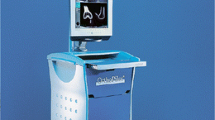Abstract
Malalignment causes abnormal forces that may lead to loosening after knee replacement. Whether a computer-assisted technique can improve the precision of implant positioning guaranteeing good long-term results in total knee arthroplasty, this is a matter of discussion. The authors evaluate the alignment accuracy of 20 primary total knee arthroplasties, performed using an image-free computer navigation systems, with standardized CT protocol and three-dimensional digital model reconstruction. The results of this study demonstrate that the image-free navigation system is able to improve accuracy in axial limb alignment and positioning of the components in the majority of cases; moreover, the difference between the mean mechanical axis value of the navigation system (179.7° ± 1.7°) and the median mean value obtained during the post-operative evaluation (180.3° ± 1.9°) is not statistically significant (P = 0.28).









Similar content being viewed by others
References
Ritter MA, Faris PM, Keating EM et al (1994) Postoperative alignment of total knee replacement. Its effect on survival. Clin Orthop Relat Res 299:153–156
Teter KE, Bregman D, Colwell CW Jr (1995) Accuracy of intramedullary versus extramedullary tibial alignment cutting systems in total knee arthroplasty. Clin Orthop Relat Res 321:106–110
Stulberg SD, Loan P, Sarin V (2002) Computer-assisted navigation in total knee replacement: results of an initial experience in thirty-five patients. J Bone Joint Surg Am 84A(2):90–98
Petersen TL, Engh GA (1988) Radiographic assessment of knee alignment after total knee arthroplasty. J Arthroplasty 3(1):67–72
Jeffery RS, Morris RW, Denham RA (1991) Coronal alignment after total knee replacement. J Bone Joint Surg Br 73(5):709–714
Berend ME, Ritter MA, Meding JB et al (2004) Tibial component failure mechanisms in total knee arthroplasty. Clin Orthop Relat Res 428:26–34
Chauhan SK, Scott RG, Breidahl W et al (2004) Computer-assisted knee arthroplasty versus a conventional jig-based technique. A randomised, prospective trial. J Bone Joint Surg Br 86(3):372–377
Jenny JY, Boeri C (2004) Low reproducibility of the intra-operative measurement of the transepicondylar axis during total knee replacement. Acta Orthop Scand 75(1):74–77
Jenny JY, Mielke RK, Kohler S et al (2003) Total knee prosthesis implantation with a non image-based navigation system: a multicentric analysis. Proceedings of 70th annual meeting AAOS, p 96
Perlick L, Bathis H, Tingart M et al (2003) Useability of an image based navigation system in reconstruction of leg alignment in total knee arthroplasty—results of a prospective study. Biomed Tech Berl 48(12):339–343
Bathis H, Perlick L, Tingart M et al (2004) Radiological results of image-based and non-image-based computer-assisted total knee arthroplasty. Int Orthop 28(2):87–90
Mason JB, Fehring TK, Estok R et al (2007) Meta-analysis of alignment outcomes in computer-assisted total knee arthroplasty surgery. J Arthroplasty 22(8):1097–1106
Lonner JH, Laird MT, Stuchin SA (1996) Effect of rotation and knee flexion on radiographic alignment in total knee arthroplasties. Clin Orthop Relat Res 331:102–106
Chauhan SK, Clark GW, Lloyd S et al (2004) Computer-assisted total knee replacement. A controlled cadaver study using a multi-parameter quantitative CT assessment of alignment (the Perth CT Protocol). J Bone Joint Surg Br 86(6):818–823
Viceconti M, Taddei F, Montanari L et al (2007) Multimod Data Manager: a tool for data fusion. Comput Methods Programs Biomed 87(2):148–159
Berger RA, Rubash HE, Seel MJ et al (1993) Determining the rotational alignment of the femoral component in total knee arthroplasty using the epicondylar axis. Clin Orthop Relat Res 286:40–47
Delp SL, Stulberg SD, Davies B et al (1998) Computer assisted knee replacement. Clin Orthop Relat Res 354:49–56
Sparmann M, Wolke B, Czupalla H et al (2003) Positioning of total knee arthroplasty with and without navigation support. A prospective, randomised study. J Bone Joint Surg Br 85(6):830–835
Jenny JY, Clemens U, Kohler S et al (2005) Consistency of implantation of a total knee arthroplasty with a non-image-based navigation system: a case-control study of 235 cases compared with 235 conventionally implanted prostheses. J Arthroplasty 20(7):832–839
Molfetta L, Caldo D (2008) Computer navigation versus conventional implantation for varus knee total arthroplasty: a case–control study at 5 years follow-up. Knee 15(2):75–79
Prakash U, Wigderowitz CA, McGurty DW et al (2001) Computerised measurement of tibiofemoral alignment. J Bone Joint Surg Br 83(6):819–824
Mizu-uchi H, Matsuda S, Miura H et al (2009) Three-dimensional analysis of computed tomography-based navigation system for total knee arthroplasty the accuracy of computed tomography-based navigation system. J Arthroplasty 24(7):1103–1110
Matziolis G, Krocker D, Weiss U et al (2007) A prospective, randomized study of computer-assisted and conventional total knee arthroplasty. Three-dimensional evaluation of implant alignment and rotation. J Bone Joint Surg Am 89(2):236–243
Stockl B, Nogler M, Rosiek R et al (2004) Navigation improves accuracy of rotational alignment in total knee arthroplasty. Clin Orthop Relat Res 426:180–186
Lutzner J, Krummenauer F, Wolf C et al (2008) Computer-assisted and conventional total knee replacement: a comparative, prospective, randomised study with radiological and CT evaluation. J Bone Joint Surg Br 90(8):1039–1044
Acknowledgments
The authors did not receive any outside funding or grants in support of their research for or preparation of this work.
Conflict of interest
The authors declare that they have no conflict of interest related to the publication of this manuscript.
Author information
Authors and Affiliations
Corresponding author
Rights and permissions
About this article
Cite this article
Tigani, D., Rimondi, E., Trentani, P. et al. Three-dimensional analysis of image-free navigation system for total knee arthroplasty. Musculoskelet Surg 95, 81–87 (2011). https://doi.org/10.1007/s12306-010-0090-7
Received:
Accepted:
Published:
Issue Date:
DOI: https://doi.org/10.1007/s12306-010-0090-7




